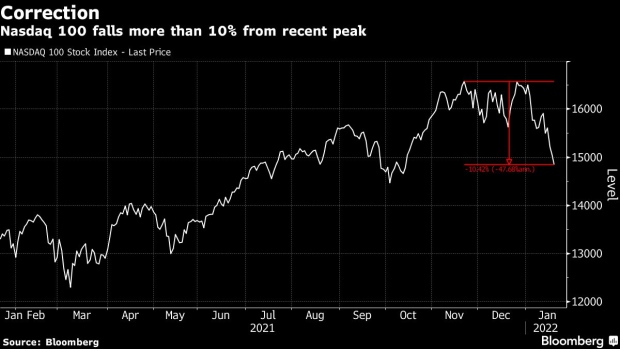Jan 20, 2022
A Year’s Worth of Nasdaq Tumult Was Condensed Into Three Weeks
, Bloomberg News

(Bloomberg) -- Many ways exist to chart shakiness in the stock market. There’s options-derived volatility indexes, price relative to moving averages and maximum drawdowns, to name a few.
Then there’s the type of whole-cloth vanishing act the Nasdaq 100 has been staging in recent weeks, sessions in which the index appears headed for resounding gains or declines -- before the whole thing goes poof in a matter of minutes. It happened again Thursday, when the tech-heavy gauge erased a 2% rally and kept falling in its worst bearish reversal in 17 months.
The session was the mirror image of Jan. 10, when the gauge came unstuck from a 2% rout and surged into the green over a period of hours. Moves like these are exceedingly rare -- there was one in 2021, two in 2019, and four the year before that. Only 2020 saw appreciably more: nine, at a time when the coronavirus was turning everything on its head.
For investors, the concern is that haywire swings may get more common at a time when the equity market’s foundation is shifting due to stiffening resolve against inflation at the Federal Reserve. While the moves had a limited effect on standard yardsticks of volatility -- The CBOE NDX Volatility Index barely budged -- the toll on trader nerves was higher.
“It used to be fear of missing out, now it’s fear of bag holding,” said Danny Kirsch, head of options at Cornerstone Macro LLC. “Investors are using any sort of rally to exit stocks, as opposed to chasing higher.”
Traders said the proximate cause of Thursday’s collapse was news that a poster child of the stay-at-home trade, Peloton Interactive Inc., had turned off production of exercise bikes amid a glut and sluggish demand. But the ability of one $10 billion company’s travails to torpedo the entire market suggested to some that the vulnerabilities run deeper.
Indeed, outside the fear over the Fed becoming the enemy of equity bulls, early results from this earnings season have yet to soothe concerns about a growth slowdown. In fact, comments about wage pressure from major banks fueled concern that corporate America may not be able to defend record-high profit margins.
“It’s starting to feel a bit chaotic,” said Mike Bailey, director of research at FBB Capital Partners. “Expectations got overly bullish this morning that markets were ready to bounce after the 10% correction for growth assets, such as the Nasdaq. The late afternoon swoons are bringing grizzled veterans back to the bad old days of late 2008 when markets tanked every day right at the close.”
The Nasdaq 100 sank 1.3% and is now more than 10% below its November all-time high. The S&P 500 reversed a gain that topped 1%, ending the day more than 5% from its record set on the first trading day of the year. Small caps plunged nearly 2%, putting the Russell 2000 17% from its last high.
To Kim Forrest, chief investment officer at Bokeh Capital Partners, the Peloton news added to market anxiety over high-value, high growth stocks heading into the Fed’s policy meeting next week. A basket of expensive software stocks, for instance, wiped out a 4.7% rally to end the session lower.
“People are really afraid of the Fed rising interest rates and the higher-priced, higher-multiple stocks,” Forrest said. “I don’t know that that’s true of all the technology stocks or whatever the industry or sector is, but I think that’s what’s happening -- people are very fearful of next Wednesday to see what’s going to happen. So that’s reducing the amount of people who are participants in the market right now.”
Market indicators show traders pricing in an interest rate cut at the Fed’s March meeting and potentially three additional quarter-point increases over the course of the year. Treasuries have been in free fall since the Fed’s hawkish turn in December, though the selling eased some Thursday.
Last year, dip buyers swooping in during equity drawdowns helped make the Nasdaq Composite look “invincibly buoyant,” said Liz Young, head of investment strategy at SoFi. But 2022 has so far proven different, as buyers haven’t stayed in long enough to hold stocks up.
“To the newer investors out there, not all pullbacks, even ones that seem persistent, are signals of an imminent bear,” she said in a note. “Sometimes, they’re shakeouts, shakedowns, removals of excess, and narrowing of gaps. That’s what I think this one is.”
©2022 Bloomberg L.P.